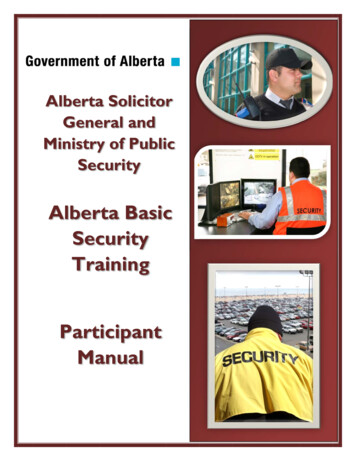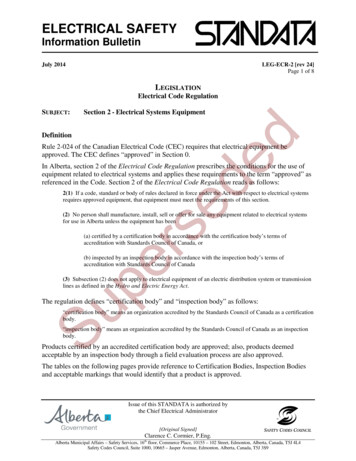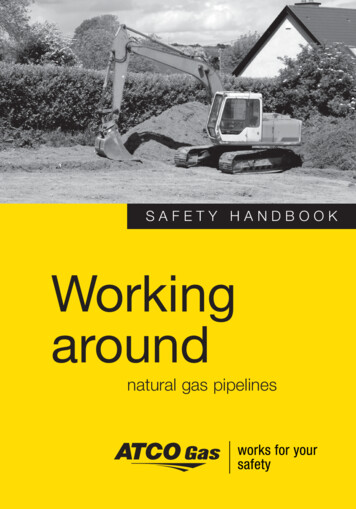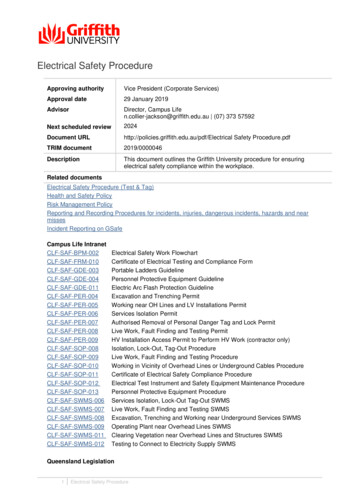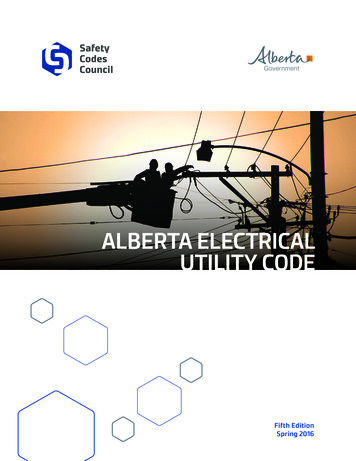
Transcription
ALBERTA ELECTRICALUTILITY CODEFifth EditionSpring 2016
Published by Alberta Queen’s PrinterOrder copies of this publication online atwww.qp.alberta.caOr at our Bookstore located at7th Floor, Park Plaza10611 - 98 AvenueEdmonton, Alberta T5K 2P7Tel: 780-427-4952Fax: 780-452-0668Email: qp@gov.ab.caMulti-user licenses are available for electronic copies of this publication for group access on anintranet website or network. Please contact Alberta Queen’s Printer for multi-user licensinginformation.
ALBERTA ELECTRICAL UTILITY CODEEstablished by theElectrical Sub-Council,Safety Codes CouncilApril, 2016CopyrightAll rights reserved. No part of this book may be used or reproduced in any formor by any means, without prior permission of the Safety Codes Council.Safety Codes Council – Suite 500, 10405 Jasper Ave NW, Edmonton, AB T5J 3N4(780) 413-0099 1-888-413-0099 Fax (780) 424-5134 1-888-424-5134www.safetycodes.ab.caPublished by the Safety Codes CouncilFifth Edition, 2016
April, 2016Alberta Electrical Utility CodePREFACEThis fifth edition of the Alberta Electrical Utility Code supersedes the previous editions, published in 2013, 2007,2002, and 1999.For this Code to be comprehensive and complete, users must have access to two CSA Standards, namely CSAStandard C22.3 No. 1-15, Overhead Systems, and CSA Standard C22.3 No.7-15, Underground Systems.General arrangementThe Alberta Electrical Utility Code (the AEUC) is divided into numbered Sections, each covering a specific topicrelated to the work. The Sections are divided into numbered Rules, with captions for easy reference, as follows:(a) Numbering system - Even numbers have been used throughout to identify Sections and Rules. Rulenumbers consist of the Section number separated by a hyphen from the 3-digit figure. The intention is thatodd numbers may be used for new Rules required by interim revisions. Due to the introduction of somenew Rules and the deletion of some existing Rules during the revision of each edition, the Rule numbers forany particular requirement are not always the same in successive editions.(b) Subdivision of Rules - Rules are subdivided as c) Tables - Tabulated information has been included in order to best organize information and to avoidunnecessary repetition of information. Tabulated information is not intended to be a mandatoryrequirement. Information provided in Tables may be made a requirement of the AEUC by the Rule whichreferences the Table.(d) Figures - Several figures have been included in this edition of the AEUC. Users are reminded that theincluded figures are intended only as examples of the requirements of the AEUC and are not intended to bemandatory requirements.(e) Appendices - Notes on Rules have been grouped into appendices. Informational notes are not intended tobe mandatory requirements. Notes on Rules located in the AEUC are found in Appendix B. Notes on Rulesfound in CSA C22.3 No. 1-15 are included in Appendix C. Notes on Rules found in CSA C22.3 No. 7-15are found in Appendix D. Information included in Appendix B, C, or D may be made a requirement of theAEUC by a Rule which references the informational note.Identification of ChangesChanges from the last edition of the AEUC are indicated with a triangle ( ) where a requirement has been added oramended. A triangle ( ) is not included where the change to a Rule is due to simple re-numbering, grammarcorrection, text formatting, or other non-functional change. The null symbol (Ø) denotes the removal of arequirement. Care must be taken not to rely on the change markers to determine the current requirements of theAEUC.Page 1 of 84
April, 2016Alberta Electrical Utility CodePage 2 of 84
April, 2016Alberta Electrical Utility CodeØACKNOWLEDGEMENTAcknowledgement is given to the many individuals and stakeholders who have provided their expertise and advice,which were so valuable to the development of this Code.Alberta Electrical Utility Code Working GroupChairman - Jim PorthCory AkinsClarence CormierDenis CroteauTerry EdmundsGarfield LeeMark LeibelRan LiBill McVeighAl NagelHenry NavisSandya NeelawalaRodger RenwickLisa Liusz SenioTravis ShmyrJulian TongBrian WagnerTony WalkerENMAXAltaLinkAlberta Municipal AffairsStantec Consulting Ltd.ENMAXCity of Red DeerFortis AlbertaCity of Red DeerENMAXAlberta Federation of REAsFortisAlbertaATCO ElectricAltaLinkEPCORATCO ElectricAnnapolis Power Systems Corp.TELUS CommunicationsAdditional ContributorsWilf BehrAlex BelayBen ChanBarry DaviesKevin GlubrechtMaha IbrahimChris JasaGlen KulakJim KulchiskyRick MacliseCarl MollerKyle NoonanStewart PurkisJerry RittwageNoel SmithFazal SubhanGraeme VanderstarKevin Van PoptaAlan XiaEPCORCity of LethbridgeAlberta Municipal AffairsStantecAlberta Municipal AffairsATCO ElectricStantecStantecCANA High VoltageEQUSGroundCAN LtdENMAXCity of LethbridgeFortisAlbertaAltaLinkATCO ElectricFortisAlbertaATCO ElectricPage 3 of 84
April, 2016Alberta Electrical Utility CodePage 4 of 84
April, 2016Alberta Electrical Utility CodeCONTENTSPREFACE.1ACKNOWLEDGEMENT .3CONTENTS .5SECTION 0 - OBJECT, SCOPE, AND DEFINITIONS . 7Object .7Scope .7Definitions .7SECTION 2 - GENERAL RULES . 9SECTION 4 - Not UsedSECTION 6 - GROUNDING OF OTHER THAN OVERHEAD AND UNDERGROUND POWERLINES . 15Grounding of Generating Stations and Substations . 15Grounding of Buildings, Pipelines, Fences, and Other Objects in Proximity to Generating Stations or Substations. 17SECTION 8 - SUBSTATIONS AND ELECTRICAL EQUIPMENT INSTALLATIONS . 19Electrical Equipment Buildings . 19Working Space near Electrical Equipment . 20Liquid-Filled Electrical Equipment . 21Guarding and Protection of Live Parts. 22Electrical Equipment and Station Yard . 23Fences . 25Circuit Breakers, Fuses, and Switches . 26SECTION 10 - OVERHEAD SYSTEMS . 29SECTION 12 - UNDERGROUND SYSTEMS . 31FIGURES . 33Figure 1 Ground Electrode and Gradient Control. 33Figure 2 Examples of Ground Electrodes . 33Figure 3 Minimum Clearances about Live Parts . 34Figure 4 Guarding of Live Parts . 34Figure 5 Dimensions of Working Space near Live Parts on Panelboards and Control Panels Indoors . 35Figure 6 Substation Fence Horizontal Separation for Exposed Parts . 35Figure 7 Typical Grounding Plan View – Fence Grounding Interconnection . 36Figure 8 Typical Substation Fence Grounding Application . 37TABLES . 39Table 1 Safe Limits of Approach Distances from Overhead Power Lines for Persons and Equipment . 39Table 2 Stranded Copper Conductor Sizes Required to Conduct Electrical Utility System Fault Currents . 39Table 3 Minimum Separation Or Clearance from Live Parts . 40Table 4 Minimum Spacing for Outdoor Switches in Free Air . 41Table 5 Minimum Vertical Design Clearances above Ground or Rails . 43Table 6 Minimum Design Clearances of Supply Conductors Attached to Buildings . 45Table 7 Minimum Design Clearances from Wires and Conductors Not Attached to Buildings, Signs, andSimilar Plant . 46Table 9 Minimum Grades of Construction for Crossings . 47Page 5 of 84
April, 2016Alberta Electrical Utility CodeAPPENDIX A - Safety Rules . 49Division A - General Requirements for Employers . 50Division B - General Requirements for Utility Employees . 52Division C - Protective Devices and Equipment . 54Division D - Safe Work Routines . 54Division E - Limits of Approach . 60Division F - Work on Energized Electrical Equipment or Lines (above 750 V) . 62Division G - Electrical Transportation Systems . 65Division H - Tree Work near Energized Electrical Equipment or Lines Performed by Utility Tree Trimmers,Utility Tree Workers, or Other Workers . 65TABLE 4-1 Limit of Approach Distances in Millimetres for Utility Employees . 68TABLE 4-2 Limit of Approach Distances in Millimetres for Qualified Utility Employees. 68TABLE 4-3 Limit of Approach Distances in Millimetres for Qualified Utility Employees Performing Live LineWork Using Rubber Gloves . 69TABLE 4-4 Limit of Approach Distances in Millimetres for Qualified Utility Employees Performing Live LineWork Using Barehand Techniques . 70TABLE 4-5 Limit of Approach Distances in Millimetres for Utility Tree Trimmers . 71TABLE 4-6 Tree to Energized Electrical Equipment or Lines Distances in Millimetres for Utility TreeTrimmers, Utility Tree Workers, and Other Workers . 72TABLE 4-7 Tree to Energized Electrical Equipment or Lines Distances in Millimetres for Utility TreeTrimmers Using Rated Insulated Tools . 73APPENDIX B - Notes on Rules . 75APPENDIX C - Notes on Rules Found in C22.3 No. 1-15 Overhead Systems . 81APPENDIX D - Notes on Rules Found in C22.3 No. 7-15 Underground Systems . 83Page 6 of 84
April, 2016Alberta Electrical Utility CodeSECTION 0 - OBJECT, SCOPE, AND DEFINITIONSObjectThe object of this Code is to establish a minimum safety standard for the installation and maintenance of electricalutility systems in Alberta. Enhancing public safety by minimizing the potential risk of shock and fire hazards andestablishing safety rules for activities near electrical utility systems have been guiding principles in its preparation.Compliance with this Code coupled with proper maintenance will provide an essentially safe installation. This Codeis not intended as an instructional manual for untrained persons.This Code and any standards referenced herein do not make or imply any assurance or guarantee by the authorityadopting this Code, with respect to life expectancy, durability, or operating performance of equipment and materialsreferenced herein.Scope(See Appendix B.)This Code applies to(1) The construction, maintenance, and replacement of:(a) electrical utility systems that are used to transform, transmit, distribute, and deliver electrical power orenergy to consumers’ services or their equivalent, including street lighting;(b) the portion of generation facilities that are used to provide inter-connection to an electrical utilitysystem up to the demarcation point as established between the generator and the electrical utilitysystem; and(c) transmission lines and electric distribution systems connected to the Alberta Interconnected ElectricSystem meeting the following conditions:(i) this Code is applied only insofar as it applies to high-voltage transmission lines and electricdistribution systems designed under the care and control of a registered engineeringprofessional experienced in the application of this Code, and(ii) the installation, design, and selection of the equipment is documented by a registeredengineering professional experienced in the application of this Code;(2) other objects located in such proximity to electrical utility systems that safety hazards or physical orinductive interference may result, and(3) activities conducted in such proximity to electrical utility systems that safety hazards or physical orinductive interference may result.Existing installations, including maintenance replacements, maintenance additions, and additions that meet theoriginal design that currently comply with prior editions of this Code need not be modified to comply with thisedition of the Code except as might be required for safety reasons by the authority having jurisdiction.Communication systems under the scope of this Code include communication systems owned by electric utilitiesfor the sole purpose of the operation of the electric utility system.Communication utilities fall under federal jurisdiction and are excluded from the scope of this Code.Notwithstanding this exclusion, the communication lines and equipment clearances identified in this Code shallapply.Definitions(See Appendix B.)For the purpose of correct interpretation, certain terms have been identified in this Code in bold text. Where suchterms or their derivatives appear throughout this Code, they shall be understood to have the meanings shown below.For terms not specifically defined below, the ordinary or dictionary meaning shall be used.acceptable – acceptable to the operator of the utility system.activity or activities – the execution of a task or action by a person or persons.Page 7 of 84
April, 2016Alberta Electrical Utility Codeapproved – equipment that has been:(a) certified by a certification body in accordance with the certification body’s terms of accreditation withthe Standards Council of Canada, or(b) inspected by an inspection body in accordance with the inspection body’s terms of accreditation withthe Standards Council of Canada.authority having jurisdiction – the organization legally authorized to enforce this Code and having jurisdictionover specified territory. (See Appendix B.)Code – the Alberta Electrical Utility Code.electric distribution system – as defined in the Alberta Hydro and Electric Energy Act. (See Appendix B.)electric utility – an entity as defined in the Electric Utilities Act. (See Appendix B.)fire point – the lowest temperature of a liquid in an open container at which vapours are evolved fast enough tosupport continuous combustion.gradient control conductor – a buried conductor used to control touch potential and step potential.ground potential – the voltage between the point in the earth under consideration and a point in the earthconsidered to be at zero voltage.ground potential gradient – the rate of change with respect to the distance along or through the earth, expressed involts per unit distance.ground resistance – the ohmic resistance measured by the two-probe method or equivalent measuring method.guarded – covered, fenced, enclosed, or otherwise protected by means of suitable covers or casings, barrier rails orscreens, mats or platforms, designed to limit the likelihood, under normal conditions, of dangerous approach oraccidental contact by persons or objects.isolated – to disconnect completely a device or circuit from other devices or circuits, separating it physically,electrically, and mechanically from all sources of electrical energy. (See Appendix B.)non-propagating liquid – an insulating liquid that, when subjected to a source of ignition, may burn but the flamedoes not spread from the source of ignition.operator of a utility system or operator of the utility system – the owner of the electrical utility system, and mayinclude a person designated by the owner to make policy decisions affecting the utility.registered engineering professional – an individual who is authorized to engage in the practice of engineeringunder the Alberta Engineering and Geoscience Professions Act and its Regulations.special permission – the written permission of the authority having jurisdiction.step potential – the difference in voltage level from one foot of a person to the opposite foot. This can be felt whena person steps across an energized path of earth. The worker forms a parallel path to the earth and current flowsthrough the worker as well as the earth. This can result in harmful current levels in some situations.substation – as defined in the Alberta Hydro and Electric Energy Act. (See Appendix B.)transmission line – as defined in the Alberta Hydro and Electric Energy Act. (See Appendix B.)supply authority – the operator of a utility system.touch potential – the difference in voltage level between energized electric lines or equipment and the earth. Thismay be felt by a person standing on the ground when they contact the electric lines or equipment and complete aparallel path to earth. The voltage may be supplied by a power system element such as a portable generator, or byunintentional energization. or by induction. Touch potential can vary greatly, as it depends on the distance fromwhere the worker is standing to the location of the source voltage.Page 8 of 84
April, 2016Alberta Electrical Utility CodeSECTION 2 - GENERAL RULES2-002Prohibition(1) No person shall construct, maintain, or replace objects, or conduct activities near electrical utility systemsor other objects described in the Scope, except in accordance with this Code.(2) If a person contravenes Subrule (1) and an unsafe condition exists, then the system, object or activity shallbe altered in a manner and within time limits specified by the authority having jurisdiction.2-004Unsafe ConditionsIf a person contravenes any of the Rules of this Code and an unsafe condition exists, then the system, object, oractivity shall be altered in a manner and within time limits specified by the authority having jurisdiction.2-006Canadian Electrical Code, Part IIf there is any conflict between any provisions of CSA Standard C22.1, Canadian Electrical Code, Part I, and thisCode, the provincial ministry responsible for the adoption of these codes shall determine which provision shallapply.2-008Referenced StandardsIf standards or other documents referenced in this Code have been amended, revised, or supplemented, theamendments, revisions, or supplements may be used where special permission has been granted.2-010Responsibility for Alterations (See Appendix B.)If any installation, construction, building or other improvement, or equipment has been installed, placed, or erectedand the installation, placing, or erection results in some other existing installation, construction, building or otherimprovement, or equipment being in contravention of this Code, then the installation, construction, building or otherimprovement, or equipment last placed in point of time shall be considered as being in contravention of this Code.2-012Interference with Systems(1) No person shall interfere with, tamper with, or wilfully damage electrical utility systems covered by thisCode.(2) Electrical utility system poles and structures shall be kept free of all materials and equipment not requiredfor the system, unless permitted by the operator of the utility system.(3) No person shall make attachments to electrical utility system poles and structures unless authorization hasbeen received from the operator of the utility system.(4) No person shall climb electrical utility system poles or structures or make connections or disconnections toelectrical utility system equipment unless the person has been authorized to do so by the operator of theutility system.(5) No person shall enter an electrical utility system generating station, substation, subsurface chamber,equipment room, or similar location unless that person is authorized to enter by the operator of the utilitysystem.2-014Activities near Overhead Power Lines (See Appendix B.)(1) This Rule applies to activities near overhead powerlines and not the movement of persons, equipment,buildings, vehicles, or objects under overhead powerlines.(2) A person must contact the operator of the utility system before activities other than those in Subrule (1)are undertaken or equipment is operated within 7.0 meters of an energized overhead line to:(a) determine the voltage of the power line; and(b) establish the appropriate safe limit of approach distance listed in Table 1.(3) Except as provided for in Subrule (4), a person must ensure that the safe limit of approach distance, asestablished in Subrule (2), is maintained and that no activities are undertaken and no equipment isoperated at distances less than the established safe limit of approach distance.Page 9 of 84
April, 2016Alberta Electrical Utility Code(4) A person must notify the operator of the utility system before activities are undertaken or equipment isoperated in the vicinity of the power line at distances less than the safe limit of approach distances listed inTable 1, and obtain the operator’s assistance in protecting persons involved.(5) Notwithstanding Subrules (1) through (4), Table 1 does not apply to OH&S Part 40 Utility Workers –Electrical.(6) A person must ensure that earth or other materials are not placed under or beside an overhead power line ifdoing so reduces the safe clearance to less than the Minimum Vertical Design Clearances above Groundor Rails as defined in Table 5 of this Code and the safe limit of approach distances listed in Table 1.(7) A person must follow the direction of the operator of the utility system in maintaining the appropriatesafe clearance when conducting activities near an overhead power line.(8) If an activity is being carried out near the safe limits of approach distances specified in Table 1, the personcompleting the activity shall assign a person to act as an observer to ensure that the safe limit of approachdistances will be maintained.(9) A person shall not excavate or perform similar operations in the vicinity of an overhead power line if itreduces the electrical and structural integrity of the power line including associated grounding equipment.2-016Buildings or Objects near Overhead Equipment or LinesNo person shall construct or place buildings or other objects within the minimum clearances from overheadequipment or lines prescribed by this Code unless it is acceptable to the authority having jurisdiction and theoperator of the utility system.2-018Moving Equipment or Buildings(1) The safe limit of approach distances listed in Table 1 do not apply to a transported load, equipment, orbuilding that is transported under energized overhead power lines.(2) If the total height, including equipment transporting it, is less than 4.15 m, the load can be moved underlines.(3) If the height of the equipment, building, or object exceeds 4.15 m and the equipment, building, or objectmust be moved under overhead power lines or communication lines, the following precautions shall betaken:(a) the person or persons responsible for moving the equipment, building, or object shall contact theoperator of the overhead lines before the move is begun and request assistance;(b) the operator of the overhead lines shall comply with the request for assistance as soon as possible; and(c) the operator of the overhead lines shall provide assistance in accordance with the requirements of theOccupational Health and Safety Act and the Safety Codes Act.2-020Excavation Activities in the Vicinity of Underground Power Lines (See Appendix B.)(1) Before an excavation is started, the person responsible for the excavation shall contact the operator of theunderground cables in the area to determine if underground cables are present at the excavation site.(2) Before an excavation is commenced, the operator of the underground cables located at the proposedexcavation site shall identify and mark any underground cables that could be interfered with when theexcavation is undertaken.(3) The person responsible for an excavation shall ensure that no excavations are undertaken within 1 m ofany underground utility cable unless:(a) the excavation is done under the control of the operator of the underground cables; and(b) the excavation method is acceptable.2-022Amusement Rides and High EquipmentThe minimum clearance between the highest point of an amusement ride or area where high equipment may bedisplayed and an overhead power line, measured horizontally between the nearest vertical planes formed by theamusement ride or the displayed equipment and the overhead power line, shall be:Page 10 of 84
April, 2016Alberta Electrical Utility Code(a) the height of the amusement ride or displayed equipment, or 8 m, whichever is greater for overheadpower lines operated at voltages above 750 V phase to phase;(b) as specified in Clause (a) for overhead power lines with bare conductors operated at voltages below750 V phase to phase; and(c) 3 m for overhead power lines with insulated or polyethylene-covered conductors operated at voltagesbelow 750 V phase to phase.2-024Consumer’s Service ConnectionThe operator of a utility system shall not connect, or allow to be connected, an electrical consumer's service to theelectric utility system unless:(a) the attachment point for conductors used on overhead systems to supply the consumer's service islocated so that the conductors maintain required clearances;(b) the metering equipment and location are acceptable;(c) the electric utility has assurance from the owner or the owner’s agent that the installation is ready forconnection and no obvious hazards should result;(d) the electric utility has received a copy of a valid permit or
April, 2016 Alberta Electrical Utility Code Page 1 of 84 PREFACE This fifth edition of the Alberta Electrical Utility Code supersedes the previous editions, published in 2013, 2007, 2002, and 1999. For this Code to be comprehensive and complete

